 |
| 1/6. Student Wang Hongchi of Archaeology at Zhengzhou University clears a tomb at the Dongzhao Ruins. Photo: IC |
Among the farmlands in the west suburbs of Zhengzhou, Central China's Henan Province, the Dongzhao Ruins, named as one of China's top archaeological discoveries of 2014, cover an area of more than 100 million square meters.
A massive "middle city" was recently discovered in the ruins, as well as the foundations of other towns. The site is part of the Erlitou Bronze Age culture, which many Chinese scholars identify with the "Xia Dynasty" (c.2070 to c.1600 BC) recorded in much later accounts and legends.
The dig looks more like a construction site than the fantasies of tomb raiding depicted in popular Chinese films such as Ghost Blows Out The Lantern. There are no traps, supernatural guardians, or acrobatics here; just the long work of mapping and excavating the relics of ancient civilizations.
Human remains, coins, and buildings have been unearthed at the site.
The Zhengzhou Municipal Institute of Archaeology has been running this project from the beginning. Researchers from the institute are based at the site, and it also established a mobile archaeological lab for sample analysis and protection at the excavation site.
Many archaeology students from Zhengzhou and Beijing are working on the project as part of their training. Local farmers have also been hired to excavate the buried treasures. Many of them have participated in a number of archaeological excavations and have become experts in the painstaking processes required. Global Times







No hay comentarios:
Publicar un comentario